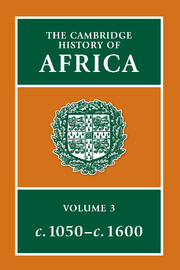Book contents
- Frontmatter
- Introduction: some interregional themes
- 1 Egypt, Nubia and the Eastern Deserts
- 2 Ethiopia, the Red Sea and the Horn
- 3 The East Coast, Madagascar and the Indian Ocean
- 4 The eastern Maghrib and the central Sudan
- 5 The western Maghrib and Sudan
- 6 Upper and Lower Guinea
- 7 Central Africa from Cameroun to the Zambezi
- 8 Southern Africa
- 9 The East African interior
- Bibliographical Essays
- Bibliography
- Index
Introduction: some interregional themes
Published online by Cambridge University Press: 28 March 2008
- Frontmatter
- Introduction: some interregional themes
- 1 Egypt, Nubia and the Eastern Deserts
- 2 Ethiopia, the Red Sea and the Horn
- 3 The East Coast, Madagascar and the Indian Ocean
- 4 The eastern Maghrib and the central Sudan
- 5 The western Maghrib and Sudan
- 6 Upper and Lower Guinea
- 7 Central Africa from Cameroun to the Zambezi
- 8 Southern Africa
- 9 The East African interior
- Bibliographical Essays
- Bibliography
- Index
Summary
There is obviously no scheme of periodization which is valid for Africa as a whole, and the opening and closing dates of this volume are not intended to be more than notional. In terms of political history, they fit best with events in North and West Africa, where the period opens with the great conquests of the Almoravids to the north and south of the western Sahara, and where it closes with the Moroccan conquest of the Niger bend, which destroyed the political unity of the western Sudan established during more than three centuries of strong rule by successive dynasties of Mali and Songhay. It is significant that these were the first and the last occasions on which conquering armies crossed the desert, and, taken together, they demarcate the high period of trans-Saharan communications, when the comings and goings of pious Muslims were reinforced by the golden trade of the Sudan, which fertilized the economic revival of all the Mediterranean lands. At its height, the Almoravid empire stretched from the Senegal to Saragossa, while that of the Almohads, which succeeded it, was narrower only in its lack of direct control over the desert routes. The golden trade, however, continued to flourish and to bind the two shores of the Mediterranean into a single network, which survived through medieval times. The Hafsid successors of the Almohads in Tunisia were trading, by the fifteenth century, as far afield as Norway in one direction and Bornu in the other.
- Type
- Chapter
- Information
- The Cambridge History of Africa , pp. 1 - 9Publisher: Cambridge University PressPrint publication year: 1977



